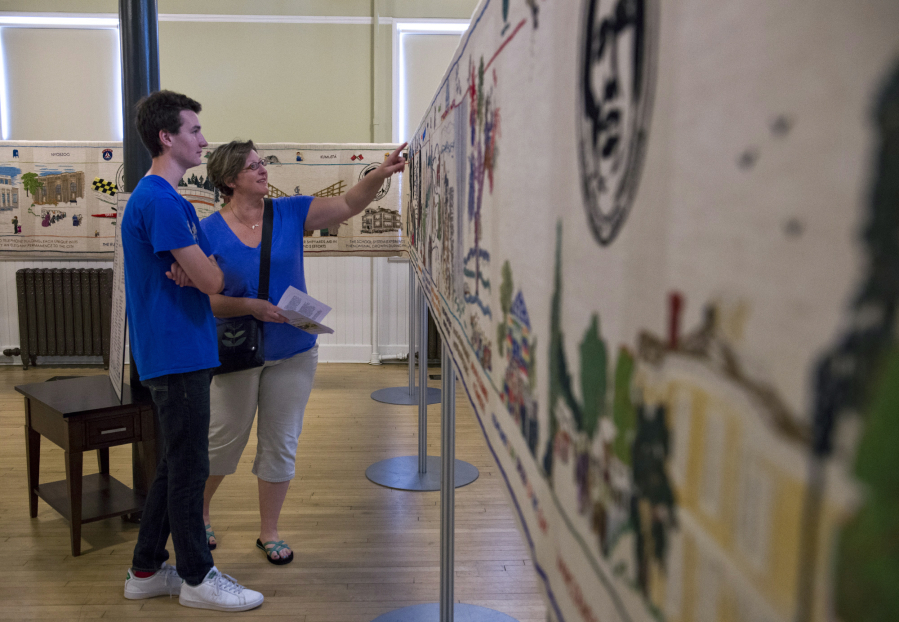Community history is folded into those 70 embroidered panels, but there also is a lot of personal history in the Fort Vancouver Tapestry.
There is the story of a dragonfly that came to Vancouver on the train. And the father and daughter who took different approaches to brick artistry. And the fire that might have destroyed an irreplaceable treasure.
They’re all woven, one way or another, into the Fort Vancouver Tapestry.
The 108-foot-long piece of textile art is back on display this week in the Artillery Barracks, 600 E. Hatheway Road.
The tapestry’s first showing since 2015 is part of a week of historic walks and programs offered by the Fort Vancouver National Trust, which also has stored the tapestry for the last year.
The Artillery Barracks is in a neighborhood where many of the historic events reflected in the panels actually took place.
One of Tuesday’s visitors had his own connection to an embroidered illustration of early Fort Vancouver. Andrew Douglas, 14, has done some costumed re-enacting in living-history programs that portray the Hudson’s Bay era.
“It’s impressive,” the Columbia River High School student said of the artistry. “I can’t imagine doing this.”
Andrew was there with his mother, Sara Douglas, who said she took her children to see the tapestry in the past.
“I love that a lot of women were interested in showing our history,” Sara Douglas said.
Their interest in the project hasn’t diminished over the years, some of the tapestry’s creators say.
“Every time I put it up, I’m impressed how much I still like it,” said Sherry Mowatt, the project’s artistic director.
Once upon a time
It started in 1999 under the leadership of Eleanor van de Water, who died in 2005, the year the tapestry was finished. Fifty-seven Northwest stitchers participated, as well as 12 who came from Japan.
Many of those women who worked on the project still get together for monthly potlucks, said Eileen Ono.
As Mowatt explained some of the distinctive features in the tapestry, she pointed to brick buildings that were stitched into the white linen, red brick by red brick.
“The linen is the mortar between the bricks,” Mowatt said.
Ono was one of the stitchers who specialized in embroidering those bricks.
“That’s appropriate,” Ono said. “My dad was a bricklayer.”
While the tapestry focuses on Clark County, there is a nod to Washington achieving statehood in 1889. The panel includes a state flag and the state insect — a green darner dragonfly.
The embroidered dragonfly was the work of Linda Downing, who was living in Sedro-Woolley when she participated in the project.
“She found a dead dragonfly in Sedro-Woolley, put it in a box and brought it with her when she took the train to Vancouver.”
The insect on the statehood panel is a life-sized representation of Downing’s dead dragonfly, Mowatt said.
Mowatt has her own stories about the tapestry. Mowatt stitched an image of herself looking out of a second-story window of her home. But she has a much more dramatic story about the tapestry itself.
Up until a year ago, when the trust offered secure storage space, Mowatt stored the tapestry at her house. She kept it in a hard-shelled, wheeled golf-club carrier. It was in a corner of her garage last summer when the garage caught fire.
When firefighters arrived, Mowatt said, she told one that he had to save the golf-club carrier: “It’s a priceless work of art!”




